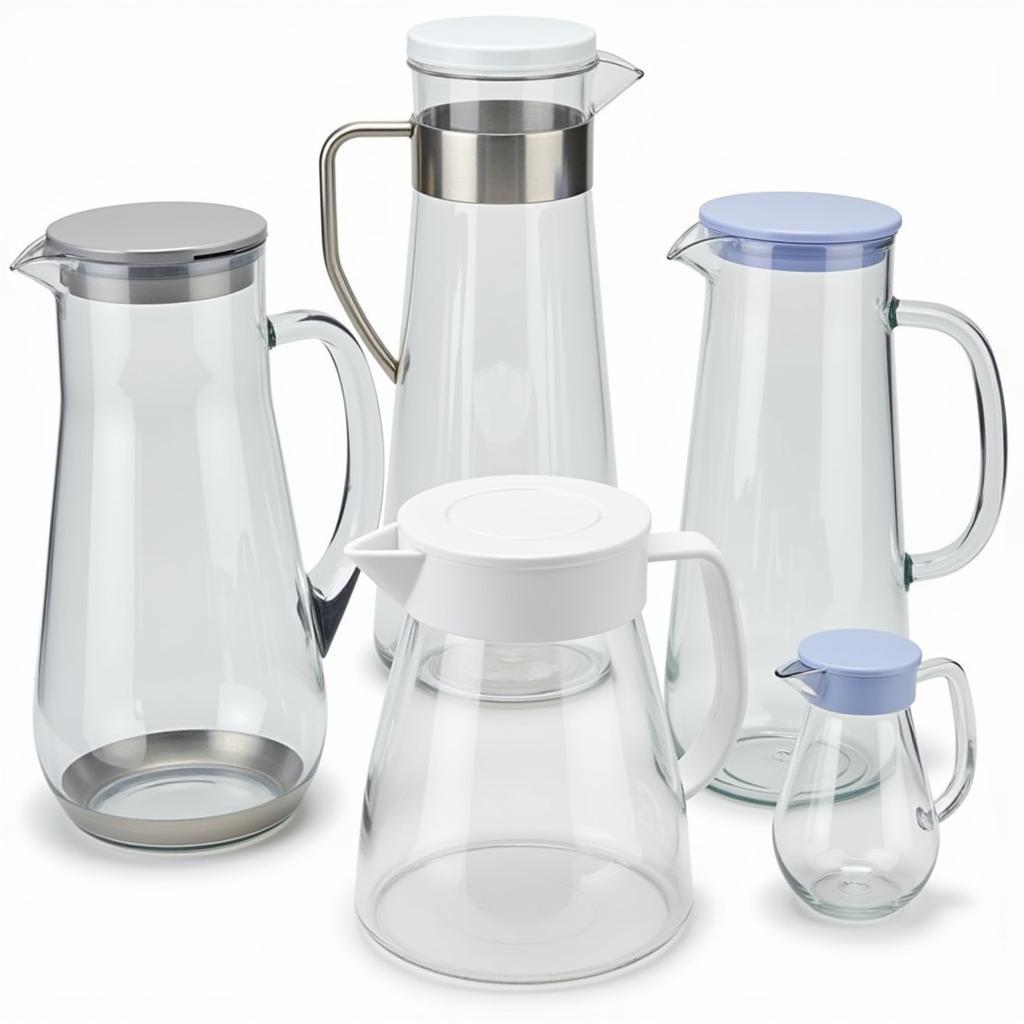Hospital water pitchers are essential items found in any hospital room. They provide a convenient and hygienic way for patients to stay hydrated throughout their stay. However, not all Hospital Pitchers are created equal. With various types, materials, and features available, choosing the right one can seem daunting. This comprehensive guide will delve into everything you need to know about hospital water pitchers, equipping you with the knowledge to make an informed decision.
 Different types of hospital water pitchers
Different types of hospital water pitchers
Factors to Consider When Choosing a Hospital Pitcher
Selecting the appropriate hospital pitcher involves considering various factors to ensure it meets the specific needs and preferences of the patient. Here are some key aspects to keep in mind:
Material
Hospital pitchers are available in various materials, each with pros and cons:
- Plastic: Lightweight, durable, and shatterproof, plastic pitchers are a practical choice. Opt for BPA-free options to ensure patient safety.
- Stainless Steel: Known for their durability and sleek appearance, stainless steel pitchers are a popular choice for hospitals. They are resistant to rust and stains, ensuring long-lasting use.
- Glass: Glass pitchers offer a classic and elegant look while being easy to clean and odor-resistant. However, their breakability poses a risk, especially in a hospital setting.
Lid Type
The lid plays a crucial role in maintaining hygiene and preventing spills:
- Open Top: While convenient for quick pouring, open-top pitchers are more susceptible to contamination.
- Snap-On Lid: These lids provide a secure closure, reducing the risk of spills and airborne contaminants.
- Flip-Top Lid: Offering a balance between convenience and hygiene, flip-top lids allow for easy pouring while minimizing exposure to germs.
Handle Design
A comfortable and ergonomic handle is essential for easy pouring, especially for patients with limited mobility:
- Standard Handle: The most common type, standard handles, offer a good grip but may not be suitable for all hand sizes.
- Large Handle: Ideal for patients with arthritis or weak grip strength, large handles provide added comfort and control.
- Built-in Handle: Some pitchers feature integrated handles molded directly into the design, offering a seamless and comfortable grip.
Capacity
Hospital pitchers come in various sizes to accommodate different needs:
- Small Capacity: Ideal for bedside use, small pitchers typically hold 1-2 cups of liquid.
- Medium Capacity: The most common size, medium pitchers, have a capacity of 2-4 cups.
- Large Capacity: Suitable for patients with higher fluid intake requirements, large pitchers can hold 4-8 cups.
Hospital Pitcher Maintenance and Hygiene
Maintaining proper hygiene is crucial to prevent the spread of infections in a hospital setting. Here are some essential tips for hospital pitcher care:
- Regular Cleaning: Wash the pitcher thoroughly with warm, soapy water after each use. Use a bottle brush to clean hard-to-reach areas.
- Disinfection: Disinfect the pitcher regularly using a hospital-grade disinfectant to eliminate bacteria and viruses.
- Air Drying: Allow the pitcher to air dry completely before refilling to prevent the growth of mold and mildew.
- Replacement: Replace pitchers that are cracked, chipped, or show signs of wear and tear.
Frequently Asked Questions
Here are some common questions regarding hospital water pitchers:
Q: Are hospital water pitchers dishwasher safe?
A: While some pitchers are dishwasher safe, it’s always best to check the manufacturer’s instructions to ensure proper cleaning.
Q: How often should I replace my hospital pitcher?
A: It’s generally recommended to replace hospital pitchers every 6-12 months or sooner if there are any signs of damage.
Q: Can I use a hospital pitcher for hot liquids?
A: The suitability for hot liquids depends on the pitcher’s material. Plastic pitchers may not be suitable, while glass and stainless steel options might be. Always refer to the manufacturer’s guidelines.
Conclusion
Choosing the right hospital water pitcher is crucial for ensuring patient comfort, hygiene, and well-being. By considering factors like material, lid type, handle design, and capacity, you can select a pitcher that best suits individual needs. Remember to prioritize regular cleaning and maintenance to maintain a hygienic environment.
For more information on hospital room essentials and accessories, explore our website for a wide range of options. We offer various hospital water pitchers and hospital bedside cabinet to enhance patient comfort and convenience.
Contact us at 02437655121 or email us at [email protected]. Our dedicated customer support team is available 24/7 to assist you. Visit us at Số 298 Đ. Cầu Diễn, Minh Khai, Bắc Từ Liêm, Hà Nội, Việt Nam.